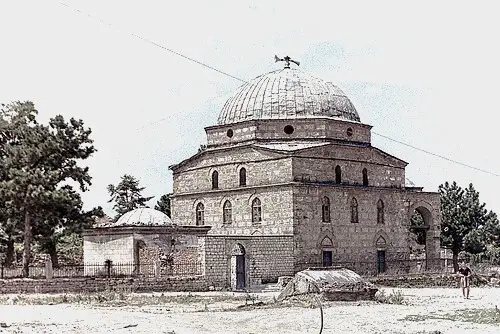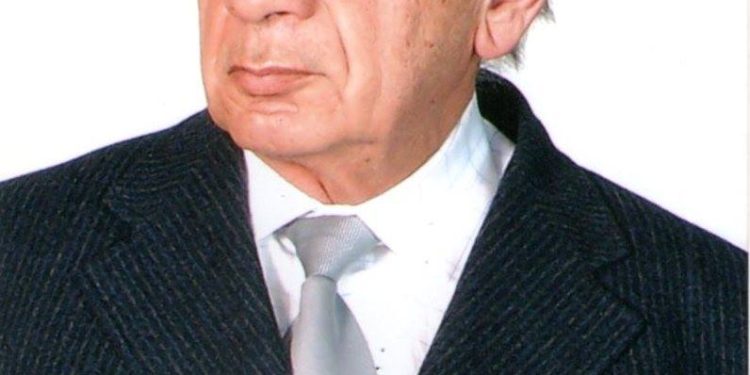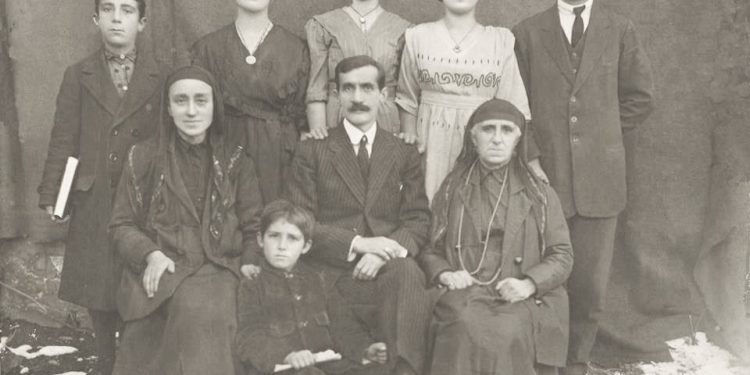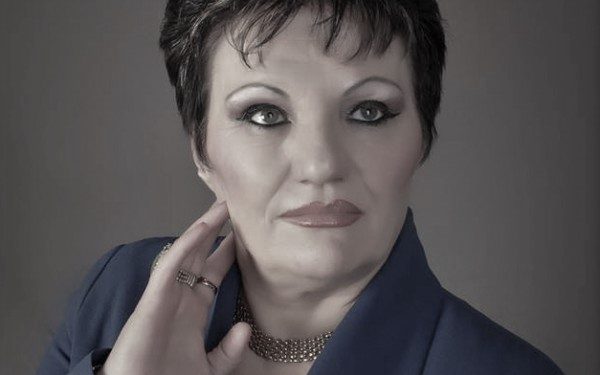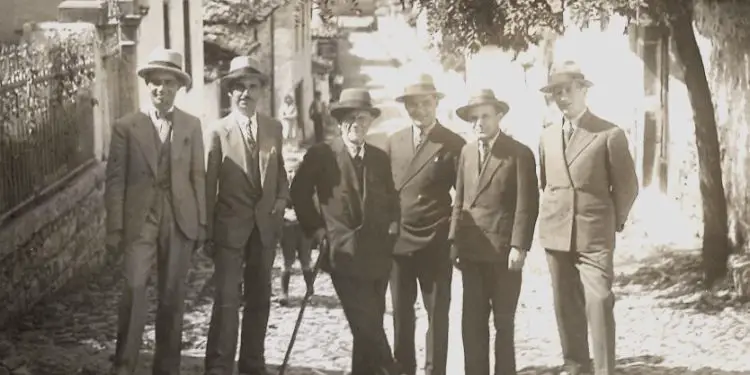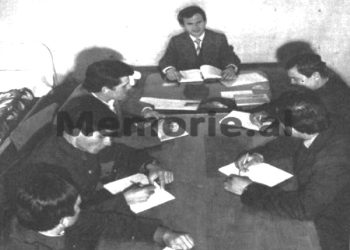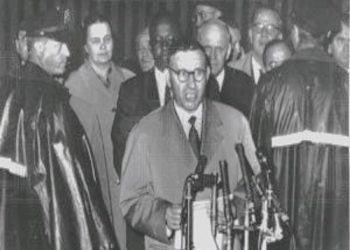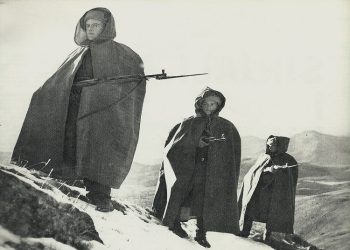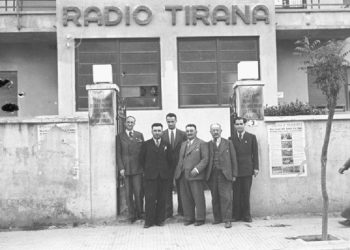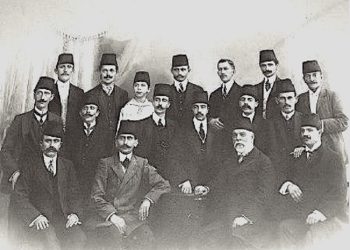By Raimonda Moisiu
Memorie.al / Starting from the sense of citizenship, patriotism, as well as to leave to future generations historical elements with national values, but also as someone born and raised in one of the famous Muslim neighborhoods of my fashionable and beautiful city, Korça, I have dreamed and had the desire to share some historical facts with national values, about the first descendants of the Mytevelijë family, a 600-year-old family. The last descendant of this family, who is still alive today and is 74 years old, the son of Hysen Bey, Rustem Hysen Myteveliu (junior), with the profession of expert in the Urban Planning Office of the city of Korça.
Having always been welcome at this door of beylers, and since I knew Mr. Rustem Myteveliu (the younger), as he was a childhood and school friend of my mother, my interest in telling me about the door of the Mytevelins, was responded to with a sense of citizenship, respect and special gratitude.
The history of the Myteveliu clan, where the Frashëri brothers are great-grandchildren
Mr. Rustem Myteveliu (the younger), begins his story with the first of this door, about 600 years ago, based also on the gynecological tree of the family, he begins with Iljaz bey Mirahori (Myteveliu). Rustem is the 16th generation and his children are the 17th generation of this famous clan. Iljaz bey Mirahori was born there around 1408 in Panarit, Korça. He was the son of the priest of Panarit. He had a large body, was 2 meters tall and lived 104 years. He received his first lessons in the lands of Panarit.
During this period, Albania was under the rule of the Ottoman Turkish dynasty and Iljazi was taken hostage, nizam, as a janissary, by the Sublime Porte. In Istanbul, he received his first lessons in the Ottoman Turkish language and then continued his schooling. Step by step, he rose to important positions, where even his name from Ilia, turned into Iljaz bey. In 1457, he participated in the war for the liberation of Istanbul; then as a commander in the war of Constantinople and rank after rank, he received the title “Mirahor”, which means general of generals, chief general. Sami Frashëri also wrote about Iljaz bey Mirahori, as his great-grandson, from the side of the mother of the Frashërlli, Emineja.
Iljazi, the Albanian who served Sultan Bayezid II
Iljazi bey Mirahori served Sultan Bayezid II, who gave him the rank of “LALE” and the title of “Professor of the Turkish Dynasty” of that time. Iljazi married the daughter of Sultan Bayezid II and from this marriage, he had three more sons: Muhamet bey, Mehmet bey and Sefer bey. Mehmet bey, the second son of Iljazi bey Mirahori, also called Ine bey, was killed in the war for the capture of Baghdad, a battle in which he was the commander of the Turkish army and was distinguished for his bravery. Later, Iljazi bey Mirahori moved to Albania, to the region of Korça, where with the signing of four firmans by Sultan Bayezid II, he was granted several villages such as: Panarit, Treska, Trebicka, Katund, Drenova,
Boboshtica and Vithkuq. By marrying the Sultan’s daughter, the latter exchanged Panarit with Leshnja, and Vithkuqi with Korça, which at that time was called Peshkëpi.
He lived almost 70 years of his life in Korça. Iljaz bey Mirahori built the mosque of Korça, there around 1496. Then he built the madrasa, the school near it, the inns and took the first steps of the market, that is, he built the Korça Bazaar. In 1504 he created the Imaret, which means Vakëf or, in today’s Albanian, Charity Mission. Two or three times a week, the poor would go and eat for free at the Imaret. Also, all the merchants who went and came for trade from Ioannina and Follorina, through Bilisht, would stay and eat at this Imaret, for free.
A neighborhood of Istanbul bears the name of Iliaz Mirahori, the founder of Korça
Ilyaz bey Mirahori, coming from Istanbul, where he received a broad culture in all fields, from the good knowledge of the city of Istanbul, a model city of the medieval period (where even today an entire neighborhood bears the name of Iljaz bey Mirahori), the latter himself knew how to skillfully use the territory for the development of the city of Korça, both geographically, economically, commercially and for the free movement of merchants and trade, especially with Janina. He created the socio-cultural base of Korça and laid the foundations of this city. In the soul and character of Iljaz bey Mirahori there was much charity, so much so that these knew no boundaries.
For this reason, he is also given the title “Myteveli”, which in Greek means “Epitropos” and in Albanian; “Caretaker”, while, adapted to today’s Albanian, it is translated “Bamirës”. Even today, the door and descendants of Mirahor the Great are known by the surname Myteveliu. This title was inherited by the son and in case there was no heir to inherit it, to lead the administration of the Imaret, the Sultan took it, and this property was not sold, but remained, Vakëf. His marriage to the daughter of Sultan Bayezid II, greatly influenced the development of the Korça region, by exempting this region from the taxes of the Turkish dynasty, even to the exclusion of young people from the obligation of compulsory military service, but also for vakëfs, he did not want taxes.
Korça’s Philanthropy, the first in Europe
Iljaz bey Mirahor Myteveliu made the largest part of his wealth into Imaret, Vakëf. In documents that have survived to our days, his idea of being a great philanthropist is clearly evident. Even in his will, a will that still exists today, and is guarded with great fanaticism by Rustem Myteveliu (the younger), he has said: “I made the largest part of my wealth Imaret, because it is the most durable part and affects the development of the region. This Imaret, Vakf, continued for 500 years and was led generation after generation by the door of the Mytevelins, the descendants of Mirahor the Great.
Until 1933, when it was led by Rustem Myteveliu (the old), i.e., the grandfather of Rustem Hysen bej Myteveliu (the younger), from whom it also took its name. Forms and ways to help the poor have existed for centuries in Albania and they have their origins, since with Iljaz bej Mirahor Myteveliu, which shows very well that, for charity, we are the first, not only in Europe, but also in the world. Iljaz bej Mirahor Myteveliu, died in 1512. His grave, that of his wife and his youngest son, Sefer Bey, are in the tomb next to the mosque built by him in 1496. The future descendants of the Great Mirahor Bey, grandsons, granddaughters, great-grandsons and great-granddaughters, would continue the path of charity, started by Iljaz Bey Mirahor Myteveliu. They would shine as patriots and patriots, but also as beys of Korça.
Rustem Myteveliu’s father (junior), Hysen Bey, as an honest patriot and patriot, participated in the social-cultural life of the city of Korça, as a member of the “Lira” group. Rustem Myteveliu’s grandmother (younger) comes from the Frashërlli family, our prominent renaissance men, Sami, Abdyl and Naimi. She is a first cousin to the Frashërlli family’s mother, Eminena. Gjylistania, coming from this renaissance men’s family, greatly influenced their patriotic education and formation. During the years of the fascist and Nazi occupation, this family of beys of Korça, the Mytevelijtë, was put at the service of the National Liberation War, for which they also donated their wealth. They gave five partisans to the war, among them the martyr of the Fatherland, Floresha Myteveliu, daughter of Ruzhdi bey Myteveliu.
Two streets, very close to each other, around the mosque built by Mirahori the Great, bear the names of Iljaz bej Mirahori and Floresha Myteveliu. But during the communist regime, the door of the Mytevelijve was silently slammed, where in one way or another, their property was confiscated, starting with the nationalization of the Rungaja Mountain, the demolition of several houses, the Imare, the bread and cooking ovens. The cemetery of the Mytevelijve suckers, the descendants of Mirahori the Great, is located behind the tomb, next to the 600-year-old mosque. There is also the grave of Rustem bej Myteveliu (the old one). But most of the Mytevelijve graves would be leveled by the communist regime and shelters would be built over their remains in case of war, that is, the bombing of enemy aircraft.
The leveling of these graves would not only be the destruction of a historical element with national value, but would also hurt the spiritual, Albanian and national feelings of the Mytevelini people. Rustem Hysen Myteveliu (the younger), an expert in the urban planning of the city of Korça, as one of the great-grandsons of Mirahor the Great, attributing the best aspects from the first of his tribe, expresses himself thus about the city of Korça, founded by Iljaz bey Mirahor Myteveliu: “Korça has a land with a favorable and suitable slope, for the development and construction of the infrastructure of the road network, residential neighborhoods, the distribution of economic, industrial or recreational areas and all of these are organically connected, which give the city a comfort, sufficient and in accordance with the climate. The hills of the city form a diverse crown, where the Morava Mountain rises above them, which protects the city from floods and strong winds. Taking advantage of these elements of the geographical position, the famous Iljaz bey Mirahor Myteveliu laid the foundations of our Korça”.
Parting from Rustem bey Myteveliu (the young one) with this story of many national values for our people, for the door of the Mytevelij beys, as the founders of my city, Korça, in my soul boiled national pride, gratitude, respect, honor and immortalization for this door of patriotic beys and for Mirahori i Madh. Walking through the cobblestone streets of my neighborhood, the neighborhood of Mirahori i Madh, the 600 years of the founding of the city of Korça were imprinted in my mind, I remembered the verses of Mihal Grameno: “Blessed are you, my Korça, o flower/ that leaves behind your friends/ like the brave on the front you rose/ that we may see forever in debt”. I will never stop writing about the history of my city, Korça, beautiful, fashionable, modern, historical, and ancient, of religious tolerance, of knowledge and culture, of education, of my dreams, of serenades, of pure loves. I bow and kiss with respect the grave of Mirahor the Great for this city that he founded and left behind.
History of the city of Korça
The area of Korça has been inhabited since ancient times. The Neolithic ruins found in this city show its continuous occupation within these 600 years. There are a large number of undiscovered archaeological centers in this city, most of which are believed to be of the same time as the Mycenaean civilization in Greece. This area played an important role in the spread of Byzantine Christianity in Albania; a church was founded in 898. The modern city began its existence in the 15th century, when Iljaz bey Mirahori, under the command of Sultan Mehmet II, developed Korça. For a long time, the city was rivaled by Voskopoja, but with its destruction in the 18th century, Korça took a position in this area that it never lost. It was a stopping point for caravan routes and, at one time, there were no fewer than 16 inns in the city. This city also became a special center for the growth of Albanian national consciousness.
In March 1878, the first Albanian-language school in Albania was established, and in 1891, the first Albanian school for girls. The area was in turmoil during the Balkan Wars and suffered extensive damage to the population and buildings, under the oppression of the Greek irredentist movements at the time. Korça was occupied by Greek forces on 6 December 1912. They soon withdrew from the decisions of the Border Commission, but were retaken by them on 10 July 1914. During World War I, the city was occupied by Austria-Hungary, again by the Greeks, and later by French troops in 1916, who proclaimed the Autonomous Republic of Korça, also known by Greece as Korica. It was established, but fell apart when Greece entered the war on the side of the Allies; Themistoklis Germenji was shot by a firing squad in Thessaloniki.
The French occupation ended in 1920, but the cultural influence continued with the French Lycée of Korça. In 1929, the inhabitants of Korça were active in the agitation for the return of Prince Vid as monarch of Albania. During the 1930s, the workers’ movement, the Korça Communist Group, grew greatly; it became the nucleus of the AKP. In 1936, a demonstration of the unemployed was brutally suppressed by Zog’s gendarmes and the liberal Korça newspaper, “Bota e Re”, was banned by the government. In World War II, the city was a stronghold of partisan movements and a point of the Anti-Fascist War. A demonstration against the invaders was stopped by German troops in 1943.
Famous historical figures and the Albanian elite of Turkey
Jahja bey Dukagjini
He is one of the sons of the family of Lekë Dukagjini, who may have been sheltered or taken hostage and grew up in the Sultan’s court, distinguished as a skilled soldier. He participated in the battles commanded by Sultan Suleiman the Magnificent, in Tameshvar (Hungary)
Osman bey Dukagjini
The grandson of the heroic Vizier, Ahmet Pasha Dukagjini, and the son of Mehmet Pasha Dukagjini. He was a wise scholar and worked as a qadi in Istanbul. He wrote the biographical work “Qaditë e Istanbul”
Architect Kasem Agai
He was born in the village of Grëmsh, in the province of Tomorica. He spent his early youth in Berat. Then his father sent him to Istanbul for professional studies. He became an assistant to Koxha Mimar Sinan (the Great) and Sedefqar Mehmet Elbasan. Distinguishing himself in architectural works, in 1595, he was appointed architect of the palace. In 1622, he became chief architect. He built the JENI XHAMI (New Mosque) of Istanbul and has many other works.
Chief Master Mehmet Isa
He is an architect of Albanian origin, one of the chief masters of the famous TAX-MAHAL Tomb in INDIA. Mehmet Isai was born in Opar.
Architect Sinan Atik Agai
This architect is also called Sinan Isuf. Although his life is not fully known, many writers say that Sinan Atiku was Albanian, educated in the Ottoman palace. He was the architect who built the FATIH MOSQUE of Istanbul
Architect Mehmet Sedefqar
He was taken from Elbasan in 1562 and became the student and assistant of Koxha Mimar Sinan. He studied in Rumelia and the Middle East. In 1597–1598, he was the general director of the fountains of Istanbul, where he served for 8 years. In 1606, he became the chief architect, building and decorating many mosques and palaces. His masterpiece is the Sultan Ahmet Mosque (Blue Mosque).
Dede Ismail Efendi
He was born in Istanbul, but comes from an Albanian family. His father, Sulejman Agai, had moved from Elbasan to Istanbul. He had bought a hamam and from this he bore the surname Kosturi, which he changed to Hamamizade (son of the hamam master). His songs were also liked by the Sultan’s Court. Later he was appointed chief musician at the Palace. The songs were of a popular character and composed in simple Turkish. The song entitled “Fati im zi, varet te lacasa e tua”, was very popular with Sultan Selim. Dede Ismail Efendi composed more than 200 musical works. Today, 160 classical Turkish songs have remained unforgettable and are listened to with pleasure.
Prominent Turkish scholars of Albanian origin
HALIL PASHA BUSHATI
Poet and scholar
HUSEIN QAMIL BEJ TEPELENA
Nephew of Ali Pasha Tepelena, poet, has published works and about 15 manuscripts.
SELIM SIRRI PASHA
Nephew of Ali Pasha Tepelena, distinguished lyric poet.
MUSTAFA RESHIT SALIH PASHA
Born in Ioannina, son of Vezir Mehmet Aqif Pasha. He had composed philosophical poems.
HASAN HAKI PASHA
Born in Shkodra and presented to the Sultan in Albanian attire. Served as deputy governor.
NUMAN MENEMENXHIOGLU
Distinguished diplomat, served as ambassador in Paris at the beginning of World War II. Member of Parliament during 1955-1956 and 1957-´58.
TURHAN PASHA
Born in Ioannina, diplomat and statesman. During the Ottoman period he served as ambassador in Vienna, Moscow, Madrid, etc. After World War I, he participated in the Albanian government. At the Peace Conference, held in Paris on February 25, 1919, he defended Albanian rights, collaborating with many delegations of the Albanian diaspora. Memorie.al




